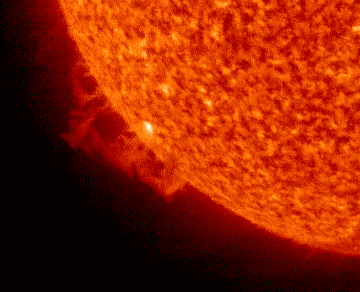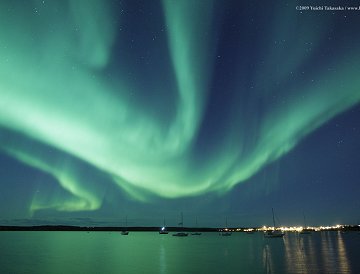| MORNING SHOW: Set your alarm for dawn. On Wednesday morning, Sept. 16th, Venus will rise in the east right beside an exquisite 7% crescent Moon. It's a beautiful way to begin the day: sky map. SOLAR ACTIVITY: Today, the Solar and Heliospheric Observatory (SOHO) is monitoring an enormous prominence on the sun's southeastern limb. Behold three hours of fiery action: 
The prominence has been growing for more than a day. As it towers higher and higher above the surface of the sun, the odds increase that it will erupt and come crashing down--a must-see. Readers, if you have a solar telescope, train your optics on the sun's southeastern limb. more images: from J. Macieszek and J. Stetson of South Portland, Maine AUTUMN LIGHTS: For reasons not fully understood by researchers, the weeks around equinoxes are the best times to see Northern Lights. The northern autumnal equinox of 2009 is only a week away and--voilà!--the show has begun:  "I had 8 people with me for an Aurora Photography Tour in Yellowknife on Sept. 12th," writes Yuichi Takasaka from the Northwest Territories of Canada. "Northern Lights started to appear from 10pm local time and stayed well after 4am!" At this time of year, the interplanetary magnetic field near Earth tends to point south, an orientation that weakens Earth's magnetic defenses against the solar wind. Under such conditions, the slightest gust of solar wind can fuel a lovely display. Polar sky watchers should be alert for Northern Lights in the weeks ahead. Sept. 2009 Aurora Gallery
[previous Septembers: 2008, 2007, 2006, 2005, 2004, 2002, 2001]
Explore the Sunspot Cycle | 
